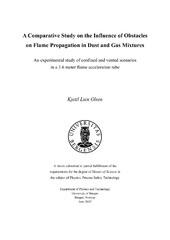| dc.description.abstract | This thesis describes an experimental investigation of flame propagation in a 3.6-meter Flame Acceleration Tube (FAT) with square 0.27m x0.27m cross section. The experiments in the FAT took place at the premises of GexCon AS at Fantoft, Bergen. Constant volume and vented explosion experiments with initial turbulence were performed, with and without baffle plates to induce additional turbulence in the flow. Experiments with both maize starch and propane-air mixtures were conducted. The use of a dump tank with a water deluge system allowed vented experiments to be conducted inside. The previous data acquisition system was reviewed and a new pressure measurement system has been tested. Plexiglas windows equally spaced along one sides of the FAT allowed flame propagation to be recorded with a high-speed video camera. The unique design of the flame acceleration tube allows for comparative studies of flame propagation in gaseous mixtures and dust clouds under the same initial conditions. The experimental data has been analyzed with an aim to identify fundamental differences between gaseous flames and dust flames, suited for research purposes and validation work of computational fluid dynamic codes for both gasand dust explosions. The introduction of additional obstacles in the tube resulted in enhanced flame acceleration for both gas and dust mixtures. The obstructions induced sufficiently high turbulence levels to give a strong indication of local quenching of the dust flames, since the denser obstacle configuration resulted in less flame acceleration than observed for the configuration with half the number of obstacles. The experiments performed with gaseous mixtures and obstacles produced such high explosion pressures that it was decided not to precede with the planned explosion series due to both safety reasons and the damage inflicted on the experimental apparatus. The effect of the different venting areas was as foreseen, where reduced vent area resulted in an increase in the reduced explosion pressure, for both fuel types. In general, the gaseous mixtures produced the highest pressures and the fastest pressure build- up. Flame propagation in a dust clouds can be characterized as premixed combustion with non- premixed substructures. Hence, the degree of volumetric combustion in clouds of maize starch, relative to rich propane mixtures, were investigated, and a clear difference in behavior during the early stages of flame propagation was found. A comparison between the measured pressure histories and recorded flame front positions suggested that the flame fronts of the dust clouds requires a certain induction length before a relative sudden increase in the rate of pressure rise takes place. | en_US |
